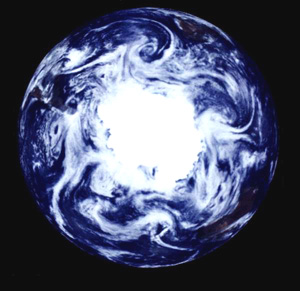Seas rise
2100, and the world's temperature has risen by 3°C. The ice cap covering Greenland is in retreat, eventually adding 7 metres to sea levels, and the west Antarctic ice sheet starts melting. Arctic summer sea ice disappears, killing the polar bear. You can sail to the North Pole. Coastal urban populations in Africa and Asia are at risk.
Rainforest retreats
The Amazon breaks down as rainfall decreases, causing the forest to collapse into savannah. It deals a devastating blow to global biodiversity - the basin is home to millions of species of wildlife - and the earth's ability to recycle carbon emissions. The ocean and the soil become net carbon contributors, further speeding global warming.
Weather worsens
Climate increasingly volatile as warming adds energy to weather systems. Events of the past decade foreshadow floods (Bangladesh, India), drought (east Africa), hurricanes and cyclones (Mozambique, Nicaragua and Honduras), forest fires (the Mediterranean, Alaska and Russia) and insect plagues (Canada) that wrack the globe.
Drought spreads
Africa's Great Lakes shrivel; Malawi's wetlands dry up and acute water shortages threaten fishing and farming livelihoods (40 percent of its GDP). Worldwide, 3 billion people face severe "water stress", with possible water wars in Central Asia and Africa. Mass migration out of North Africa. By 2100 Peru faces drought as its glaciers melt.
Ecosystems collapse
A fifth of the world's surface has changed significantly, from melting Arctic tundra to vanishing cloud forest in Queensland, Australia (exterminating the native Golden Bowerbird). A 3.7°C rise would kill or critically endanger 40 percent of Africa's mammals. Up to 38 percent of Europe's birds and 20 percent of its plants are extinct or at risk.
Famine grows
Snow melts earlier in the year so water sources dry before crops finish growing in areas such as the Sierra Nevada and northern India, left. Up to 400 million people at risk of hunger as 400 million tons of cereal crops are lost, with Africa hit worst. Crop yields fall for the first time since the agricultural revolution in Europe, Russia and America.
What if ...
55 percent of the world's population would be exposed to dengue fever - up from 30 percent in 1990. Insect-borne diseases like dengue and malaria, which already claim 1.3 million lives a year, would spread away from the equator towards the poles.
3bn population at risk of water shortages as rising temperatures dry surface water and reduce rainfall.
54 percent of mammals will die in South Africa (worst-case scenario). Up to 40 percent of the country's birds, 70 percent of butterflies and 45 percent of reptiles will also be extinct or critically endangered.
Half of nature reserves that will no longer be able to fulfil their conservation objectives, due to dying species or habitats.
10°C drop in British temperature during wintertime, once global warming reaches the point where it disrupts Atlantic Ocean currents and switches off the Gulf Stream, which currently warms our island. The North Atlantic marine ecosystem could also collapse when half the plankton die. It is not known exactly what the "tipping point" temperature for this is, but 3°C would be close. |



